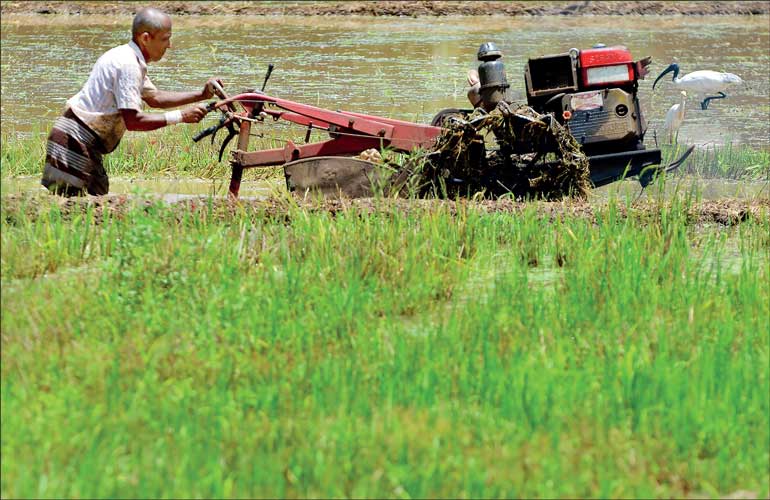Thursday Jan 08, 2026
Thursday Jan 08, 2026
Monday, 27 September 2021 00:00 - - {{hitsCtrl.values.hits}}

Neither the farmers nor the consumers are winners though they were expected to be winners due to Government intervention – Pic by Shehan Gunasekara
 The Government through its short-sighted actions has made farmers, consumers and millers worse off. This article makes a strong case to seriously consider fresh solutions in a rational manner to make all the stakeholders better off.
The Government through its short-sighted actions has made farmers, consumers and millers worse off. This article makes a strong case to seriously consider fresh solutions in a rational manner to make all the stakeholders better off.
No winners
Neither the farmers nor the consumers are winners though they were expected to be winners due to Government intervention. Farmers cannot sell their produce and cover their cost and consumers cannot buy at the controlled price. Millers are unlikely to be winners unless their profits from speculative actions are very high. Their milling capacity lies idle. The Government has lost its popularity and the credibility.
The Government will have to secure enough supply to feed the nation by importing rice, spending scarce foreign exchange. According to media reports, the Government will place an order soon to import 6,000 metric tons of rice from Pakistan. The lowest price of one kilogram of white rice in Pakistan itself is equivalent to $ 0.93, about Rs. 200 in Sri Lankan currency at the current official rate of exchange.
No information is available about the CIF cost of one kilogram of Pakistani rice when it lands in Sri Lanka. (This order of 6,000 metric tons seems to be a part of the bigger plan to import 100,000 metric tons of rice to keep the prices low and to assure food security). Future food security is a real concern in the face of fast-deteriorating foreign exchange reserves and sharply diminished harvests.
To make matters worse, the hastily-imposed restrictions on the importation of chemical fertilisers will drastically reduce the productivity of the farms (see https://island.lk/are-we-making-rational-decisions-in-the-rice-sector/). It is estimated that the next harvest of the country will be lower by about 20-30% compared with the previous season. Hence, the actual cost of production per a kilo of paddy will increase. Farmers are facing a double jeopardy! (See https://groundviews.org/2021/08/27/realistic-or-just-rhetoric-the-ban-on-chemical-fertilizer/)
A way forward
Japan may serve as an example for Sri Lanka to follow. Japan is considered a success story when it comes to domestic rice production. The Japanese Ministry of Agriculture, Forestry and Fisheries (MAFF) has estimated the year 2020 rice production at 7.23 million tons from harvested area of 1.37 million hectares. As this production is excessive, MAFF established a production target of 6.93 million tons for the year 2021 (see, Expansion of Support Payments for Rice and New 2021 Rice Production Targets; Japan; Report Number: JA2020-0193, United States Department of Agriculture, Foreign Agricultural service).
A Google search showed the number of farmers in 2010 as 1.63 million, 80% of which part-timers. The average income of a farmer who grew only rice was Yen 4.41 million (1 Yen = Rs. 2 approx), and about 90% of that income was from non-agricultural sources, including pensions.
Rice production in Japan is considered essential to support Japanese food security and Japan has established a tariff rate quota (TRQ) on imports of rice and rice products. Japan has a 767,000 MT minimum access World Trade Organization (WTO) tariff rate quota (TRQ), commonly referred to as Minimum Access (MA) (see, Global Agricultural information Network Report No. JA 8039, dated 7/3/2018). The tariff rate quota system does not restrict/stop direct imports. Imports can still be made without a tariff quota certificate, provided an extremely high duty is paid (https://www.customs.go.jp/english/c-answer_e/kojin/3104_e.htm)
Japan encourages local rice production. Rice farmers are protected by means of tariffs, high import taxes and TRQ quota on importation of rice. Rice is imported to fill the shortfall in the projected domestic production. Farmers cultivate their land, earn/supplement their living, and keep the surroundings pleasant. The downside is that the consumers must pay a much higher price for rice compared with the international price of rice.
The price of a kilogram of white rice in Japan was Yen 515 on 9 July 2021 (Rs. 937 at the rate of Rs.1.82 per Yen), the highest price in the world! This price is around four times of the CIF price of one kilogram of white rice if the rice is imported. However, Japanese consumers seem to pay this high price without a grudge because they can afford to do so thanks to their high level of per capita income. When it comes to rice, Japanese are proud to eat their locally-produced rice and are prepared to pay the highest price for it.
By artificially controlling prices at a low level, the Sri Lankan Government is penalising farmers, mostly peasants, whose standard of living is extremely low. If Sri Lanka wants to achieve “true” self-sufficiency, farmers will have to be encouraged to produce the entire requirement of the country.
Consumers in Sri Lanka prefer local varieties of rice and consider these varieties as products different to imported varieties (as a differentiated product). Because of this differentiation, as well as cultural and historical reasons going back over 2500 years at least, Sri Lanka will be able to justify a high import duty on rice (like Japan does) and protect the farmers up to a reasonable level without encouraging inefficiency. Sri Lanka will be able defend its position in international forums like Japan has been doing.
Knee-jerk reactions like price controls, raids and acquisitions of rice stocks will not solve the problem. These desperate actions will aggravate the problem and harm the country’s economy. What is the Government going to do once the existing (hoarded) stock is finished, if farmers and millers do not produce the country’s rice requirement?
Everyone concerned, i.e., the farmers, consumers, owners of rice mills will end up as losers; there will be no winners. To assure food security, the country will have to continue importing rice from overseas, paying with precious, scarce foreign exchange.
Short-term and medium-term solutions
A policy mix closer to a ‘market-based solution’ can be recommended:
1. Remove arbitrary minimum and maximum prices and other restrictions on domestic rice/paddy trade.
2. Remove quantitative restrictions on rice imports and introduce an import tariff/taxes which would ensure a domestic price of about 50% above the world market price of rice. Use Thai FOB rice of price as a benchmark which is around $ 0.50 a kg (about Rs. 101) at the moment (http://www.thairiceexporters.or.th/price_eng.html). When Freight, Insurance and 40% tariff is added the imported cost of a kilogram would be around Rs. 150. This price will help protecting paddy farmers (will also enable them to cover their increased costs and have a decent income).
3. Introduce a selective ‘rice allowance’ to low-income households. It can be part of ‘Samurdhi’. (Government revenue from rice import duty, income taxes from millers and traders can be used for this purpose). The main problem one can foresee here is that selective intervention in Sri Lanka eventually becomes a political game. The World Bank recommends a ‘universal basic income’ in place of all existing subsidy schemes, including Samurdhi.
Recommendation No. 3 may seem naïve because of the burden on the Treasury and the logistics (and corruption) involved in paying such an allowance to deserving families. However, the idea is not naïve or novel. Several countries in the world (example, Australia) give ‘house rent allowances’ and ‘gas and electricity allowances’ to low-income families instead of imposing harmful price controls that disrupt markets.
The cost of a ‘rice allowance’ for 1.5 million families (say, six million people if four in a family at Rs. 1,000 per month) will be Rs. 18 billion a year. (This rice allowance is just to cover the increase in the market price, i.e., the difference between the controlled price (Rs. 90) the Government wishes to maintain and the new market price of Rs. 150). The damage being done to the economy now by price controls is much more than Rs. 18 billion.
The Government will be able to recoup some or probably all of this outlay from import taxes on rice and by collecting (profit-based) taxes on increased profits (income tax/corporate tax) of millers, large farmers and traders. Profit-based tax cannot be/should not be passed on to the consumers. More importantly, the above recommendations pave the way for the Government to give enough space for a market economy to function for everyone’s benefit.
(The writer is a former head of Finance and Financial Planning Disciplines at Deakin University, Australia. He has held several senior management positions in academia, commerce, and industry during a career spanning over 40 years.)